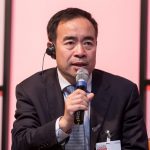At the end of Automotive Logistics China 2016, held in Chengdu, industry decisions makers and experts discussed the importance of better logistics planning and engineering, reducing costs to stay competitive, and adapting to new technology.
China’s growth continues to push the automotive supply chain and distribution network across the country, spreading further west from the traditional economic powerhouses on the east coast. Even as slower growth, and the potential for a slowdown, has worried some investors, supply chain managers and experts continued to adjust to life in the ‘new normal’. Logistics providers and manufacturers are looking to improve their services and reduce cost, while improving links to new plants and markets. Interesting along the old ‘Silk Road’ is rising, with more companies exploring long-distance rail services between Europe and China in particular.
But with growth and uncertain and costs rising, the focus on competitive supply chains and logistics is becoming more important. At the end of Automotive Logistics China 2016, industry leaders summed up their findings from the conference, talked about their future ambitions, and discussed what direction they think China’s automotive logistics industry is headed.
Xu Guangqing, managing director, logistics engineering & ops, SAIC GMAbutan (Al) Lindsey, deputy director, MP&L, Changan FordAndreas Subbe, director logistics, SCMA Asia Pacific, Continental AutomotiveMa Zengrong, vice general secretary, Chinese Automotive Logistics Association of the China Federation of Logistics and Purchasing (CFLP)
The comments have been edited for clarity and brevity.
-20160421-8472-1024x682.jpg)
What are some of your top projects or ambitions for the next year and beyond?
 Xu Guangqing, SAIC GM: China’s automotive industry is going to slow down. For automotive logistics, close competition will be the permanent thing. Some OEMs are working together with suppliers to reduce cost, and are using ‘Industry 4.0’, ‘Made in China 2025’, and big data analytics to go deeper and make themselves stronger to reduce costs. I hope more suppliers and OEM colleagues are interested in this topic and we can discuss this issue over the next year.
Xu Guangqing, SAIC GM: China’s automotive industry is going to slow down. For automotive logistics, close competition will be the permanent thing. Some OEMs are working together with suppliers to reduce cost, and are using ‘Industry 4.0’, ‘Made in China 2025’, and big data analytics to go deeper and make themselves stronger to reduce costs. I hope more suppliers and OEM colleagues are interested in this topic and we can discuss this issue over the next year.
 Andreas Subbe, Continental Automotive: We want to double our sales figures by 2020. It’s a big challenge for logistics. Times will be more challenging under the ‘new normal’. There will be more consolidation, and there will be more focus on the competitiveness of the supply chain, as well as more competition on the OEM side and pressure on the tier-one side. On the transportation side, there will need to be collaboration to set some standards in China. I think we can eliminate waste with these ideas. We need more reliability in the supply chain, and not to have inventory stored in warehouses. This is where we need support from OEMs and can provide solutions on the returnable packaging side.
Andreas Subbe, Continental Automotive: We want to double our sales figures by 2020. It’s a big challenge for logistics. Times will be more challenging under the ‘new normal’. There will be more consolidation, and there will be more focus on the competitiveness of the supply chain, as well as more competition on the OEM side and pressure on the tier-one side. On the transportation side, there will need to be collaboration to set some standards in China. I think we can eliminate waste with these ideas. We need more reliability in the supply chain, and not to have inventory stored in warehouses. This is where we need support from OEMs and can provide solutions on the returnable packaging side.
 Abutan (Al) Lindsey, Changan Ford: Being new to China, the conference was a good opportunity to meet some logistics service providers. Looking forward, we see a lot of the same challenges. For a young company in China that has seen quick growth over the past few years, cost has become critical for Changan Ford. During market slowdown, logistics services become very important. We are currently looking to our partners and LSPs to see how we can do business on the inbound side, and reduce waste on inbound transportation, and it’s going to take an LSP that understands transportation networks and how to leverage volumes to optimise inbound shipping. Currently, suppliers drive that, and putting a lead logistics provider between our suppliers and us would help.
Abutan (Al) Lindsey, Changan Ford: Being new to China, the conference was a good opportunity to meet some logistics service providers. Looking forward, we see a lot of the same challenges. For a young company in China that has seen quick growth over the past few years, cost has become critical for Changan Ford. During market slowdown, logistics services become very important. We are currently looking to our partners and LSPs to see how we can do business on the inbound side, and reduce waste on inbound transportation, and it’s going to take an LSP that understands transportation networks and how to leverage volumes to optimise inbound shipping. Currently, suppliers drive that, and putting a lead logistics provider between our suppliers and us would help.
As truck regulations change this year, we’ll be looking at the impact. My question and challenge to logistics providers is, ‘how do you collaborate and provide a solution that covers more than one OEM with respect to automotive logistics?’ How can you take a significant change in China’s transportation network and optimise it across multiple OEMs so we fully utilise that transportation rather than having carriers dedicated to OEMs and returning empty?
 Ma Zengrong, CFLP: We are moving to a more mature stage of development, but we have a lot of room to grow. Mr Chen [Chen Zhongwei from Chengdu Municipal Port and Logistics Office] mentioned yesterday that we have 170m cars right now in China with a 1.3 billion population. Even if we are being conservative, we should have 400m cars. This is a big gap, and we have a lot of room to grow. Every year we should have 35m new cars: now we are producing 24m.
Ma Zengrong, CFLP: We are moving to a more mature stage of development, but we have a lot of room to grow. Mr Chen [Chen Zhongwei from Chengdu Municipal Port and Logistics Office] mentioned yesterday that we have 170m cars right now in China with a 1.3 billion population. Even if we are being conservative, we should have 400m cars. This is a big gap, and we have a lot of room to grow. Every year we should have 35m new cars: now we are producing 24m.
The industry is in a time of transition. The government will introduce more strict regulation in the automotive logistics market, including for car carrier lengths. This new regulation is a good thing, and will help us to change our industry. I believe for automotive logistics, we will be on the way to match our counterparts in developed countries.
In the past ten years we have achieved so much. Logistics companies work with OEMs and parts manufacturers and aftersales. All these parties work together to form a complete supply chain. In the future, technology will become the key element. We need more refined growth and technology to build on capability. During the conference, we have spoken about going green, getting smarter, established standards, connectivity. All this technology will be our future drivers.
How have logistics service providers (LSPs) in China developed?
 Xu Guangqing, SAIC GM: Mr Ma said that we will have regulatory policies from the government this year. For OEMs and logistics companies, the new policy will increase costs by tens of billions. This is an attempt by the government to regulate our industry. There is a lot of chaos. There will be temporary pains and hard times, especially when the macro economy isn’t doing well. As OEMs and as LSPs, we have to think about innovation. A lot of OEMs are trying to reduce costs. For LSPs, in the future, we all need to do that. One speaker said to reduce miles, they could ship other products back, this is something innovative. Whoever comes up with innovative technology or methods will take the leading ground in the future.
Xu Guangqing, SAIC GM: Mr Ma said that we will have regulatory policies from the government this year. For OEMs and logistics companies, the new policy will increase costs by tens of billions. This is an attempt by the government to regulate our industry. There is a lot of chaos. There will be temporary pains and hard times, especially when the macro economy isn’t doing well. As OEMs and as LSPs, we have to think about innovation. A lot of OEMs are trying to reduce costs. For LSPs, in the future, we all need to do that. One speaker said to reduce miles, they could ship other products back, this is something innovative. Whoever comes up with innovative technology or methods will take the leading ground in the future.
 Andreas Subbe, Continental Automotive: LSPs have improved over the years, but there are now higher expectations from our side. On the other hand, labour costs have increased in China, which means we have to introduce more automation. There are still significant inventories on the outbound side, but with more transparency and more modern infrastructure you can overcome this.
Andreas Subbe, Continental Automotive: LSPs have improved over the years, but there are now higher expectations from our side. On the other hand, labour costs have increased in China, which means we have to introduce more automation. There are still significant inventories on the outbound side, but with more transparency and more modern infrastructure you can overcome this.
 Al Lindsey, Changan Ford: Reducing inbound inventory that suppliers are holding and the costs associated is one issue. But with respect to performance or quality, a lot of progress has been made with LSPs. Seeing the global growth of logistics providers here in China gives us the chance to benchmark suppliers in other places.
Al Lindsey, Changan Ford: Reducing inbound inventory that suppliers are holding and the costs associated is one issue. But with respect to performance or quality, a lot of progress has been made with LSPs. Seeing the global growth of logistics providers here in China gives us the chance to benchmark suppliers in other places.
 Ma Zengrong, CFLP: You [delegates] are the experts in the logistics industry. For the industry to further develop, we need innovative ideas and the motivation to collaborate. The industry association [CFLP] is designed to provide you with a communication platform. In traditional Chinese medicine, you have to balance the airflow throughout the body: suppliers are the most crucial part to generate smooth flow in the supply chain.
Ma Zengrong, CFLP: You [delegates] are the experts in the logistics industry. For the industry to further develop, we need innovative ideas and the motivation to collaborate. The industry association [CFLP] is designed to provide you with a communication platform. In traditional Chinese medicine, you have to balance the airflow throughout the body: suppliers are the most crucial part to generate smooth flow in the supply chain.
We still have a huge potential for cost reduction and the elimination of waste. In China’s manufacturing industry, there is a huge amount of waste and that is the reason our costs are so high. That’s why we would like to work with tier one and two suppliers to help them change their mindset. With the new standards coming out soon, we hope to take advantage of the opportunities to have a ‘free flow’
Do you see any advantages for Chinese logistics providers to go global?
 Al Lindsey, Changan Ford: Ford exports a lot of material out of China to support its global product line-up. The hope would be that as companies become globalised in their capability, it would be another driver in reducing costs and creating natural loops in production material, as well as vehicle shipments on some of those lines. It would be a definite benefit to Ford to have another world class LSP who could add to the competition base and drive down costs in the future.
Al Lindsey, Changan Ford: Ford exports a lot of material out of China to support its global product line-up. The hope would be that as companies become globalised in their capability, it would be another driver in reducing costs and creating natural loops in production material, as well as vehicle shipments on some of those lines. It would be a definite benefit to Ford to have another world class LSP who could add to the competition base and drive down costs in the future.
Do you see the advantages or benefits of ‘One Belt, One Road’ and rail links between Europe and China?
 Ma Zengrong, CFLP: In China, on one hand we respect the market forces, and on the other hand we respect the power of the communist party. The communist party will always find the right direction for China. ‘One belt, one road’ is a strategic choice by the government, and the government needs to take action. There has been a lot of activity taking place along the belt and road. The markets along the road are relatively less advanced than China so we have opportunity to export to those markets. There are two big countries on each end of the belt, and in between there are markets with potential.
Ma Zengrong, CFLP: In China, on one hand we respect the market forces, and on the other hand we respect the power of the communist party. The communist party will always find the right direction for China. ‘One belt, one road’ is a strategic choice by the government, and the government needs to take action. There has been a lot of activity taking place along the belt and road. The markets along the road are relatively less advanced than China so we have opportunity to export to those markets. There are two big countries on each end of the belt, and in between there are markets with potential.
 Al Lindsey, Changan Ford: Listening to the presentations and seeing the scope of the ‘one belt, one road’ policy, I think it will benefit China in the long run. Barriers to import do need to be addressed though, so more product can come in. It will be a spur for the economy and also help build relationships with European countries and others in between. It’s a great concept.
Al Lindsey, Changan Ford: Listening to the presentations and seeing the scope of the ‘one belt, one road’ policy, I think it will benefit China in the long run. Barriers to import do need to be addressed though, so more product can come in. It will be a spur for the economy and also help build relationships with European countries and others in between. It’s a great concept.
 Andreas Subbe, Continental Automotive: It gives us a good opportunity for delivering parts, and additional opportunities. However, it is currently like a chicken and egg: it lacks reliability, but if there is more volume coming, it will be more competitive price wise.
Andreas Subbe, Continental Automotive: It gives us a good opportunity for delivering parts, and additional opportunities. However, it is currently like a chicken and egg: it lacks reliability, but if there is more volume coming, it will be more competitive price wise.
 Xu Guangqing, SAIC GM: ‘One belt, one road’ has become more and more prominent. OEMs are establishing factories in western China. In Chongqing, a lot of factories are being set up, and the same is happening in Chengdu. OEMs value the fact that when China’s western economy grows and develops, it has a great future.
Xu Guangqing, SAIC GM: ‘One belt, one road’ has become more and more prominent. OEMs are establishing factories in western China. In Chongqing, a lot of factories are being set up, and the same is happening in Chengdu. OEMs value the fact that when China’s western economy grows and develops, it has a great future.
How do you see your logistics processes and providers developing in China?
 Al Lindsey, Changan Ford: I think there’s a large chasm between the US market and China with regard to the flow of material inbound to the plant. The joint venture [Changan Ford] has obviously been effective at bringing parts to the plant and protecting the volumes needed to be competitive. As the company matures and grows into many factories, we have to start looking at the cost of how we do business. We need to look at how to recover volume without running premium overtime, looking at the cost of bringing parts in, and how much material you hold in hand. One of the biggest challenges I’ve seen is scheduled stability. As the market shifts frequently in China, there are swings at minimal notice, and that flows back into the transportation network. Adding in the volume we did last year created a premium and put a lot of material in the air. From a joint venture perspective, stability can assist the logistics provider in developing more disciplined processes and focusing on the cost of that business as well.
Al Lindsey, Changan Ford: I think there’s a large chasm between the US market and China with regard to the flow of material inbound to the plant. The joint venture [Changan Ford] has obviously been effective at bringing parts to the plant and protecting the volumes needed to be competitive. As the company matures and grows into many factories, we have to start looking at the cost of how we do business. We need to look at how to recover volume without running premium overtime, looking at the cost of bringing parts in, and how much material you hold in hand. One of the biggest challenges I’ve seen is scheduled stability. As the market shifts frequently in China, there are swings at minimal notice, and that flows back into the transportation network. Adding in the volume we did last year created a premium and put a lot of material in the air. From a joint venture perspective, stability can assist the logistics provider in developing more disciplined processes and focusing on the cost of that business as well.
 Xu Guangqing, SAIC GM: Compared to GM factories in the US, China plants perform better in terms of KPIs. We’re not just competing with GM in the US, but OEMs around the world and we need more than just KPIs. Nokia is close to going out of business and I’m sure they have great KPIs. You cannot just look at KPIs, that’s misleading. You need to study cross function and cross industry. Maybe one day GM and Ford will become part of a telecom company if we do not cross our industries, and the cars will be manufactured by Foxconn.
Xu Guangqing, SAIC GM: Compared to GM factories in the US, China plants perform better in terms of KPIs. We’re not just competing with GM in the US, but OEMs around the world and we need more than just KPIs. Nokia is close to going out of business and I’m sure they have great KPIs. You cannot just look at KPIs, that’s misleading. You need to study cross function and cross industry. Maybe one day GM and Ford will become part of a telecom company if we do not cross our industries, and the cars will be manufactured by Foxconn.
Are you looking at ‘Made in China 2025’?
 Xu Guangqing, SAIC GM: We are. We feel a sense of urgency and a crisis coming. If we don’t do cross industry, other people will. Google and Apple are doing well at autonomous cars. Automotive players are going through great changes, and no one can predict how the industry will change. We are changing and I hope our logistics suppliers can change with us. Maybe Uber will ship our parts and our automobiles. Watch out for companies like Uber. I want to raise the alarm that you have to be innovative. What can we do to prepare for the future?
Xu Guangqing, SAIC GM: We are. We feel a sense of urgency and a crisis coming. If we don’t do cross industry, other people will. Google and Apple are doing well at autonomous cars. Automotive players are going through great changes, and no one can predict how the industry will change. We are changing and I hope our logistics suppliers can change with us. Maybe Uber will ship our parts and our automobiles. Watch out for companies like Uber. I want to raise the alarm that you have to be innovative. What can we do to prepare for the future?
 Ma Zengrong, CFLP: Combination shipments would be good. There are a lot of empty miles and trucks. We need to get rid of old habits and think innovatively. We need to have open communication, hear about new things, see the future and identify trends. It is easy to get lost, and go very fast in the wrong direction.
Ma Zengrong, CFLP: Combination shipments would be good. There are a lot of empty miles and trucks. We need to get rid of old habits and think innovatively. We need to have open communication, hear about new things, see the future and identify trends. It is easy to get lost, and go very fast in the wrong direction.
 Al Lindsey, Changan Ford: Ford has created a mobility division that focuses on not just the manufacturing and distribution of vehicles, but looking at getting from point A-to-B. The younger generation doesn’t necessarily want money tied up in vehicles, or doesn’t want to deal with parking, or snow. Ford has seen that vision and is trying to understand what it will look like in the future. I’m quite sure that will trickle into the joint venture here in China as we better define who we are in the future.
Al Lindsey, Changan Ford: Ford has created a mobility division that focuses on not just the manufacturing and distribution of vehicles, but looking at getting from point A-to-B. The younger generation doesn’t necessarily want money tied up in vehicles, or doesn’t want to deal with parking, or snow. Ford has seen that vision and is trying to understand what it will look like in the future. I’m quite sure that will trickle into the joint venture here in China as we better define who we are in the future.
How will the automotive industry change in China?
 Ma Zengrong, CFLP: Traditional dealers have to get prepared to embrace the future. Don’t be afraid that this future may have some negative influence. Embrace changes. It’s the same case with parts: the current Chinese parts market is changing. It will not be far in the future that people will be able to buy authentic parts from e-commerce stores online and fake products will be wiped out.
Ma Zengrong, CFLP: Traditional dealers have to get prepared to embrace the future. Don’t be afraid that this future may have some negative influence. Embrace changes. It’s the same case with parts: the current Chinese parts market is changing. It will not be far in the future that people will be able to buy authentic parts from e-commerce stores online and fake products will be wiped out.
 Xu Guangqing, SAIC GM: Cars can be bought online but the percentage is still low. It will rise over the coming years. However you need virtual reality technology to sell cars, to allow people to test drive and feel the interior without visiting a dealership. The future purchasing model will be totally different. Selling cars online will be a megatrend. Although, another question, do people need to purchase cars in the future? Maybe no one will want to buy a car. Or maybe a car will be delivered in-front of your door, and you won’t need to drive as it’s autonomous. I believe the dealership model as we know it today will disappear in the future.
Xu Guangqing, SAIC GM: Cars can be bought online but the percentage is still low. It will rise over the coming years. However you need virtual reality technology to sell cars, to allow people to test drive and feel the interior without visiting a dealership. The future purchasing model will be totally different. Selling cars online will be a megatrend. Although, another question, do people need to purchase cars in the future? Maybe no one will want to buy a car. Or maybe a car will be delivered in-front of your door, and you won’t need to drive as it’s autonomous. I believe the dealership model as we know it today will disappear in the future.
 Andreas Subbe, Continental Automotive: It has been said that the car is no longer important, but it is still the dream to own a car in China, that is part of the so-called ‘Chinese dream’. We shouldn’t be worried for the next few years. From our end some supply chains will change: the tier-one relationship will change, and new players will be coming in. However, we need somebody to support us in the future, rather than us not being quick enough with new technologies.
Andreas Subbe, Continental Automotive: It has been said that the car is no longer important, but it is still the dream to own a car in China, that is part of the so-called ‘Chinese dream’. We shouldn’t be worried for the next few years. From our end some supply chains will change: the tier-one relationship will change, and new players will be coming in. However, we need somebody to support us in the future, rather than us not being quick enough with new technologies.
Click here for a full report from Automotive Logistics China.





































